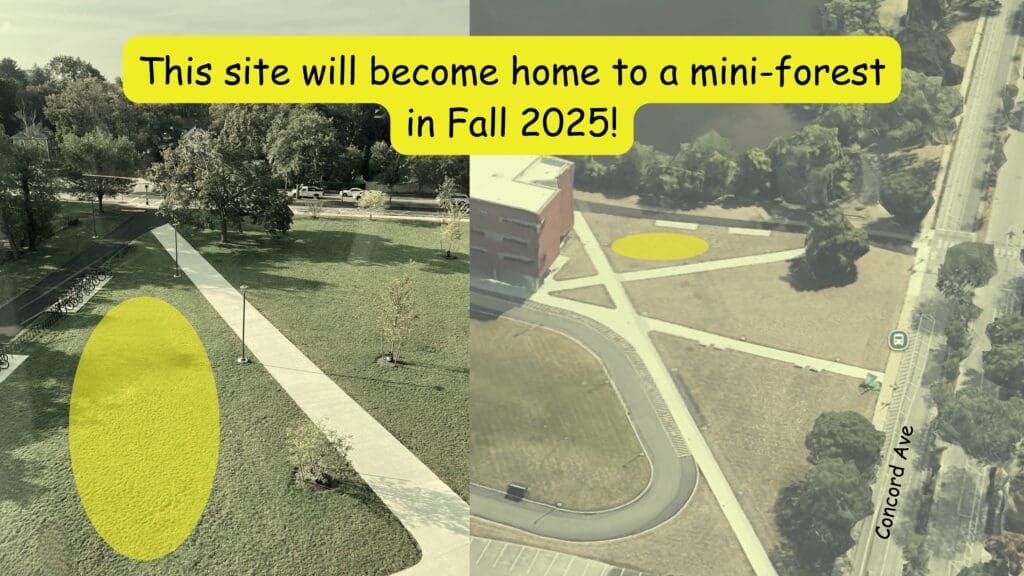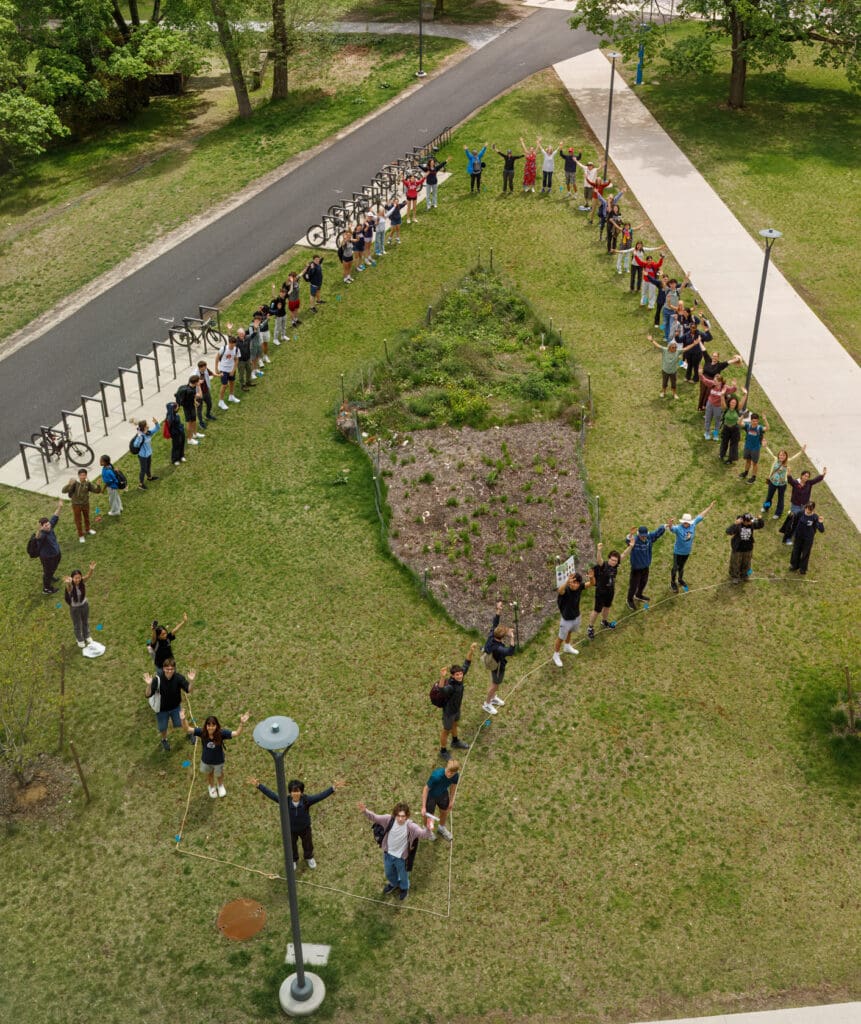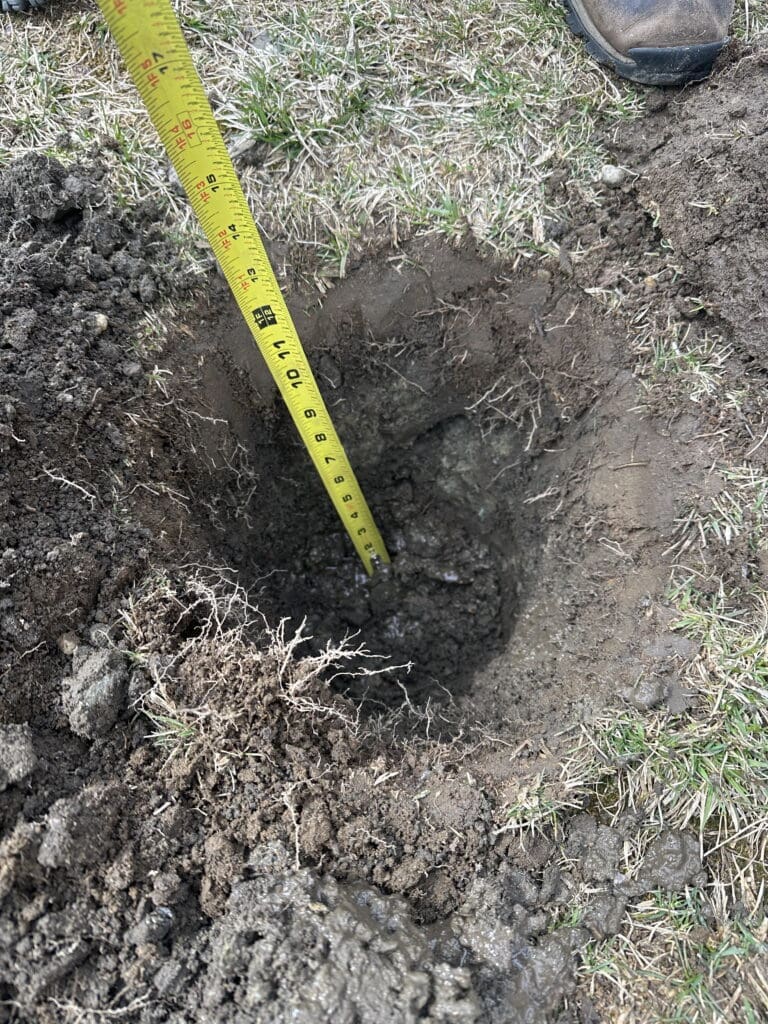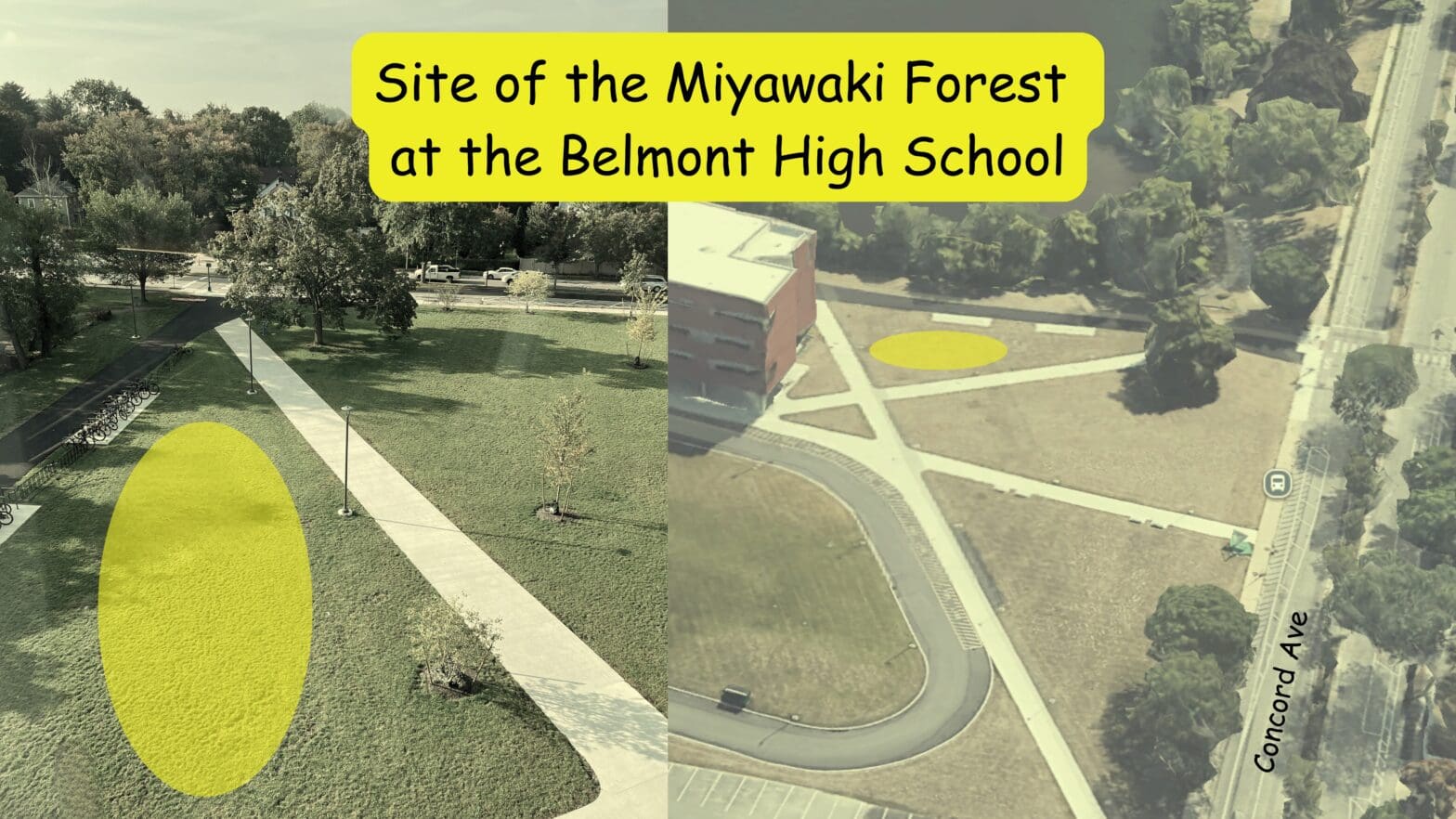BHS Mini-Forest at Belmont High School
Sign up to join the community planting the BHS Mini-Forest on
October 4, 2025!
If it rains, planting day will move to October 5. Sign up for updates on any changes.

In Fall 2025, the Miyawaki Forest Action Belmont (MFAB), under the guidance of Biodiversity For a Livable Climate (Bio4Climate), will be planting a mini-forest using the Miyawaki Forest at the Belmont High School.
Miyawaki Forest Action Belmont (MFAB) is an intergenerational group of local residents dedicated to establishing Miyawaki forests in Belmont. Our focus is on education and community building, providing Belmont a hands-on place to learn about environmental stewardship and biodiversity.
Our committee members include:
- Jean Devine
- Jess Hausman
- Ralph Jones
- Holly Kong
- Ranganath Nayak
- Michelle Oishi
- Kirsten Waerstad
- Sarah Wang
- Anne-Marie Lambert
We are seeking volunteers to help bring Belmont’s first mini-forest to life by planting hundreds of native plants. Your support will turn this vision into reality, benefitting both human and non-human communities.

Why plant a mini-forest at Belmont High School?
- Help Belmont restore local ecosystems and mitigate the impacts of climate change through a diversity of native trees and shrubs
- Educate students about biodiversity and natural systems
- Create an outdoor space for teaching science, language, and visual arts
- Empower students to positively influence their environment
- Improve stormwater absorption on site
- Mitigate the urban heat island effect
- Strengthen the sense of community within Belmont Town and Schools
If you’d like to be part of this transformative project, please fill out this sign-up form to express your interest in volunteering.
The forest will need stewards and volunteers to plant seedlings, spread mulch, organize materials and volunteers, and take care of the forest after planting, including wedding, litter removal and data collection. While we are prioritizing participation from Belmont residents and high school students, everyone is welcome to join. Kids are encouraged to get involved, too!
We look forward to connecting with you and collectively healing our shared Earth in harmony with native plants, microorganisms, sunlight, and natural cycles. Once the final planting date is set, we will share more details via email.
Get Involved: Have questions about volunteering and more? Email us at miniforestbelmont@gmail.com
Grow With Us: Help turn Belmont High School into a biodiversity hotspot—donate here!
We have broad community support:
- The Belmont School Committee
- Belmont Department of Public Works
- Belmont High School Principal Isaac Taylor
- Belmont High School Climate Action Club
- Sustainable Belmont
- Mystic Charles Pollinator Pathways Group
- Mass Audubon Habitat Education Center
- Friends of Barbara Becker
- Belmont Garden Club
- Belmont Citizens Forum
- Town Shade Tree Committee
I am extremely excited at the prospect of having this forest established on the Belmont Highschool (BHS) campus. My belief is that the Miyawaki forest project will not only further enhance biodiversity at BHS, but will continue to educate students and community members about the benefits and beauty of creating habitats for native plants and creatures, and offsetting the impact of the constructed environment such as runoff. The forest will also be a valuable educational resource for the school. There are clear benefits for a science and engineering curriculum, which are enhanced by opportunities to observe and collect data from the natural world. But beyond that, the space can be used for mindfulness, creative inspiration, and reflection. My support for this program is unequivocal….“
– Isaac Taylor, Principal, Belmont High School
Belmont’s Shade Tree Committee heartily endorses the Miyawaki forest project at the high school. The Miyawaki forest will grow faster than traditional plantings, creating a dense micro forest in just a few years. Native trees and shrubs will increase the diversity of Belmont’s canopy (in keeping with a 2023 recommendation from the town tree inventory report!) and will support local wildlife. It’s a wonderful opportunity to engage students townwide, as well as the community at large. Generations of Belmont residents will benefit from the forest for years to come.”
– Belmont Shade Tree Committee
BHS Mini-Forest – Upcoming Events
FOSTER-A-TREE PROGRAM
Pick up a tree or shrub to tend over the summer for planting in the Mini-forest in the Fall.
Fill out this form to reserve your plant!
For instructions on care, go here.
Sustainability Day
June 12
4 – 6:30 pm
Visit with us and Foster A Tree
Belmont Farmers Market 10 Claflin St, Belmont, MA 02478
DIG ON DEMAND – Native Plant Fundraiser
Ongoing
Ongoing
Online
Shopping for native plants? Consider getting them freshly dug from a local garden and supporting the BHS Mini-forest project with a donation. See this spreadsheet of currently available species. Happy gardening!
Past events on May 3, 7, 17, and 18 included native plant sales, distribution of saplings as part of the Foster-a-Tree program, and a pop-up photo opportunity where community members outlined the mini-forest’s shape.
Updates
Site Assessment
On March 26, 2025, we carried out a site visit to assess the soil. At around 12 inches deep, we encountered a layer of clay—an expected finding, given the area’s history and the nearby Clay Pit Pond, which hints at the site’s clay-rich past. A lab test of the soil showed that the top layer is sandy loam. We also did a simple ribbon test to help confirm the soil texture. In addition to the soil work, we surveyed the existing vegetation on the site, around the pond, and in a nearby grove as part of our Potential Natural Vegetation (PNV) research.




Potential Natural Vegetation (PNV) for the Planting List
On April 23, 2025, we visited the Bolton Flats Wildlife Management Area in Lancaster, MA, to conduct research on Potential Natural Vegetation (PNV). Based on the soil conditions at our Belmont High School site, botanist Walter Kittredge recommended using a High-terrace Floodplain Forest as a model. This forest community now serves as the reference and inspiration for developing our planting list. During the visit, and under Kittredge’s guidance, we observed and identified characteristic plant groupings within this ecosystem.

Foster-A-Tree Program
Saplings are ready to be distributed for the Foster-a-Tree Program! Community members are invited to care for a sapling over the summer and then bring it to planting day, where it will become part of our growing mini-forest.

About Miyawaki Forests
The Miyawaki Forest is an ultra dense, biodiverse pocket forest that recreates the complexity of natural forests and the relationships and processes that help them grow strong and resilient. By giving home to a vast array of native species, they boost the biodiversity of the area and nurture pollinators, supporting and restoring ecosystems.
They sequester carbon in the soil, reduce air pollution and soil contamination, improve water absorption to buffer against flooding and erosion, and cool the surrounding area to mitigate the urban heat island effect. They also create a living classroom for people and communities to learn about native ecology, engage in stewardship, and experience the interconnectedness of the natural world.
Related Resources and Links
- Our main Miyawaki Forest Program page
- Bio4Climate’s Miyawaki Forest video playlist
- ‘A Little Forest with a Towering Task‘ – Short documentary on the Miyawaki planting process and the ‘grounded hope’ behind the work
- ‘Tiny Forests with Big Benefits‘ – A feature of our Cambridge forests and other Miyawaki plantings in The New York Times
- Mini-Forest Revolution: Using the Miyawaki Method to Rapidly Rewild the World by Hannah Lewis, published by Chelsea Green in June 2022








HI, I am a gardener in Belmont and live on the intersection of Cowdin and Middlecott street. I would like to insert a tiny comment that the Miyawaki forest can be grown in conjunction with a space where plants that extend biodiversity can also grow, either those that grow at the edge of woodland, or even ones that grown in the sun but are excellent for pollinators. I can help with these programs, as I grow most things from divisions and seed. Nepeta, Salvias, Foxgloves, helianthus, rudbeckias, echinacea, sedum etc. are quite easy to grow from divisions and seed and bulbs like Lilies come every year. I would like to collaborate with this program. Any forest is a commitment to biodiversity but so are flowering species. They extend habitat to insects as well. Please visit my front garden to see how I grew a garden where I had an old tree removed. All plants were grown from divisions. I would love to join this committee.
I am a member of the Committee behind this effort, and I would welcome your involvement. By the way, I live on Orchard Street, a few hudred feet from the site of the proposed forest.